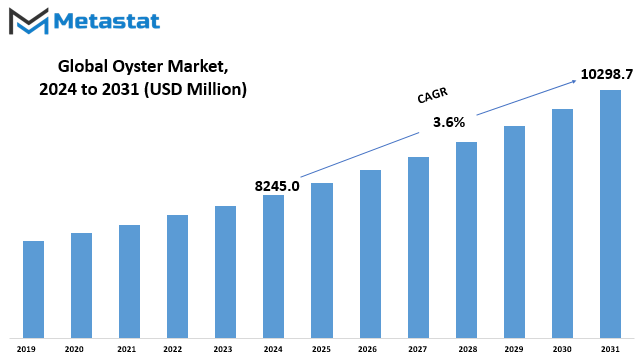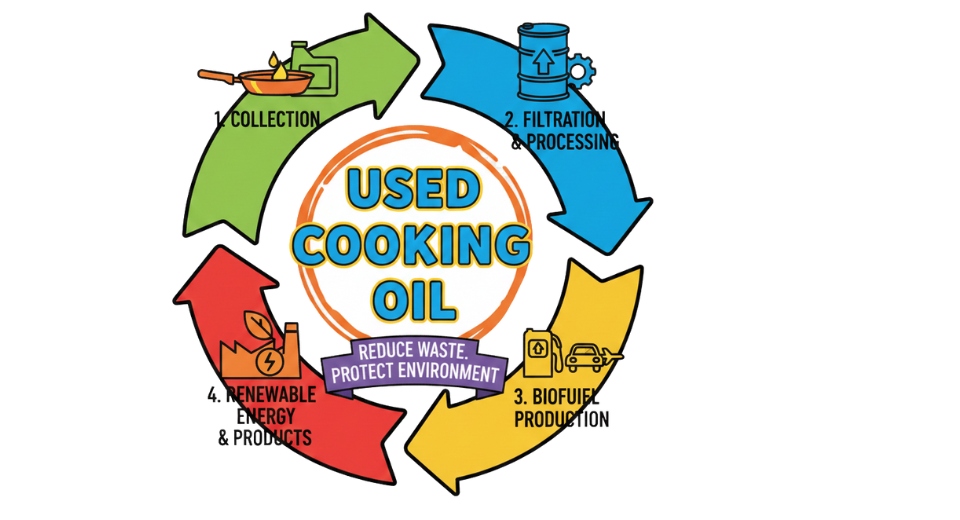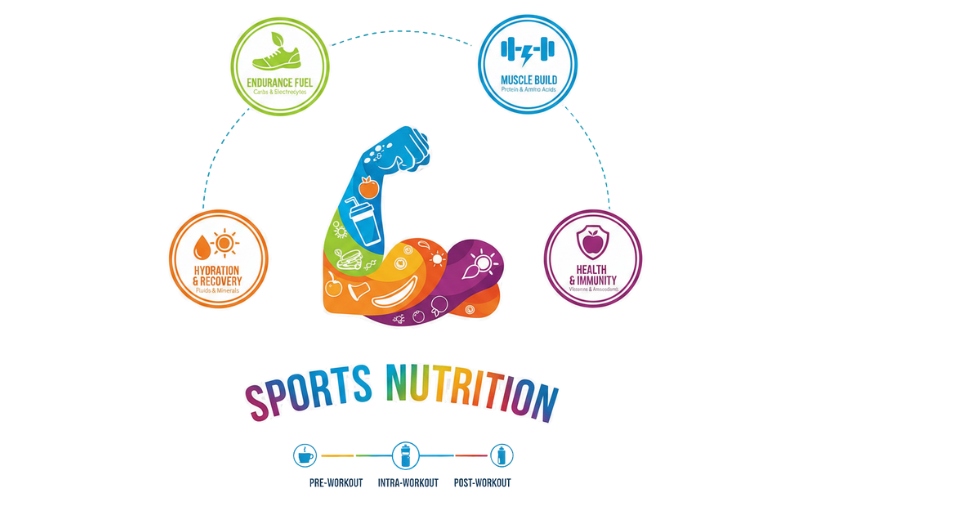MARKET OVERVIEW
The Global Oyster Market within the seafood industry, embodying a rich tapestry of cultural, economic, and environmental threads. This market, characterized by the cultivation and distribution of oysters, serves as a nexus where traditional practices converge with modern techniques to meet the discerning palates of global consumers. Anchored in coastal regions worldwide, the industry encapsulates the essence of sustainable aquaculture and plays a pivotal role in shaping culinary landscapes.
The Global Oyster Market encompasses a vast network of farmers, harvesters, and distributors engaged in the cultivation and delivery of oysters to a diverse clientele. From the pristine waters of the Pacific Northwest to the tidal flats of the Atlantic, oyster farming has become an integral part of coastal economies. This industry transcends mere commerce; it is a tradition deeply rooted in maritime heritage, where each mollusk carries the flavors of its unique terroir.
In recent years, the market has witnessed a resurgence fueled by a growing appreciation for sustainable seafood practices. As consumers become increasingly conscious of the environmental impact of their choices, the oyster industry has adapted by embracing eco-friendly cultivation methods and stringent quality controls. This shift has not only elevated the market's standing in the culinary world but has also positioned it as a beacon of responsible aquaculture.
Moreover, the Global Oyster Market serves as a fascinating intersection of tradition and innovation. While some farmers adhere to age-old practices handed down through generations, others leverage cutting-edge technology to enhance production efficiency. This juxtaposition of time-honored techniques and modern advancements paints a vivid portrait of an industry in constant flux, navigating the delicate balance between heritage and progress.
Beyond its economic and cultural dimensions, the Global Oyster Market is intricately linked to environmental sustainability. Oyster beds contribute to coastal ecosystem health by acting as natural water purifiers, filtering vast volumes of seawater and improving overall water quality. The symbiotic relationship between oyster farming and environmental well-being underscores the market's role in fostering a harmonious coexistence between human activity and nature.
The Global Oyster Market transcends its role as a mere economic entity, evolving into a multifaceted tapestry interwoven with cultural heritage, environmental stewardship, and culinary innovation. This industry's resilience lies not only in its ability to adapt to changing consumer preferences but also in its commitment to preserving traditions and safeguarding coastal ecosystems. As the global demand for sustainable and responsibly sourced seafood continues to rise, the Oyster Market stands poised to navigate the currents of change and remain an integral part of the culinary and ecological landscapes.
Global Oyster market is estimated to reach $10298.7 Million by 2031; growing at a CAGR of 3.6% from 2024 to 2031.

GROWTH FACTORS
The global Oyster market is a dynamic landscape influenced by various factors. One of the primary drivers propelling its growth is the recognition of health and nutritional benefits associated with consuming oysters.
Oysters, being a rich source of essential nutrients, contribute significantly to a balanced diet. They are renowned for their high protein content, essential amino acids, vitamins, and minerals. Incorporating oysters into one's diet can promote overall health and well-being. The presence of omega-3 fatty acids in oysters further adds to their nutritional value, offering benefits for heart health.
Despite the positive aspects, the Oyster market faces certain restraints. One notable concern is related to environmental factors. Oyster harvesting and cultivation can have environmental implications, such as habitat alteration and water quality concerns. These challenges necessitate a balanced approach to ensure sustainable practices and minimize the impact on ecosystems.
Moreover, regulatory compliance is a significant aspect affecting the Oyster market. Adhering to regulations governing harvesting, processing, and distribution is crucial for the industry's sustainability. Striking a balance between meeting regulatory requirements and maintaining economic viability poses a challenge for market players.
In the face of these challenges, there is a growing awareness of environmental concerns associated with Oyster farming. Consumers are becoming more conscious of the ecological footprint of their food choices. This shift in consumer behavior is pressuring the industry to adopt more sustainable practices, creating an opportunity for those willing to invest in environmentally friendly and ethical approaches.
One such opportunity lies in the realm of sustainable aquaculture. As the demand for oysters continues to rise, there is a need for innovative and sustainable farming practices. Embracing aquaculture methods that minimize environmental impact and promote responsible resource management can position businesses for long-term success.
The global Oyster market is navigating a landscape shaped by health and nutritional benefits, environmental concerns, regulatory compliance, and opportunities for sustainable aquaculture. While the industry faces challenges, the potential for growth and innovation is evident. As consumers increasingly prioritize the nutritional value of their food and its impact on the environment, the Oyster market can evolve in a way that benefits both individuals and the planet. Striking a balance between meeting consumer demands, regulatory standards, and environmental sustainability will be key to the continued success of the Oyster market in the years to come.
MARKET SEGMENTATION
By Oyster Type
The global Oyster market exhibits a diverse landscape, with various Oyster types contributing to its overall dynamics. These Oyster types encompass Cupped Oyster, Pacific Cupped Oyster, American Cupped Oyster, Penguin Wing Oyster, and others.
In the expansive global Oyster market, the different Oyster types play a significant role in shaping the industry’s trajectory. Among them, the Cupped Oyster stands out as a prominent player, contributing to the market’s overall robustness. Its distinct characteristics and flavor profile make it a sought-after choice among consumers worldwide.
Moving beyond the Cupped Oyster, the Pacific Cupped Oyster also commands attention in the market landscape. Its unique attributes add diversity to the Oyster market, catering to varying preferences among consumers. This diversity is a key aspect of the market’s appeal, offering options that suit different tastes and culinary applications.
The American Cupped Oyster represents another facet of the global Oyster market. With its own set of characteristics and flavor nuances, this Oyster type contributes to the rich tapestry of choices available to consumers. The market’s ability to accommodate such variety ensures a dynamic and engaging experience for Oyster enthusiasts.
In the Oyster market, the Penguin Wing Oyster emerges as a distinctive option, appealing to those seeking a different taste profile. Its presence further expands the range of choices within the market, reflecting the adaptability and responsiveness of the industry to consumer preferences.
Beyond the specified Oyster types, the category of Other Oysters adds an element of surprise and discovery to the market. This catch-all designation encompasses lesser-known varieties, encouraging exploration and experimentation among consumers. The inclusion of such diverse options underscores the Oyster market’s commitment to providing a comprehensive and inclusive array of choices.
As consumers navigate the global Oyster market, they encounter a spectrum of flavors, textures, and culinary possibilities. The market’s ability to accommodate a variety of Oyster types reflects not only the richness of the seafood industry but also the evolving preferences of consumers globally. Each Oyster type contributes to the market’s overall vibrancy, ensuring that there is something for everyone in thIs culinary journey.
The global Oyster market is a tapestry woven with the diverse threads of Cupped Oyster, Pacific Cupped Oyster, American Cupped Oyster, Penguin Wing Oyster, and other intriguing varieties. This diversity defines the market’s character, offering consumers a dynamic and engaging experience as they explore the wide-ranging options available to them. As the Oyster market continues to evolve, it remains a testament to the ever-changing and adaptable nature of the seafood industry.

By Sales Channel
The global Oyster market is a vast landscape with diverse sales channels driving its growth. These channels play a pivotal role in shaping the accessibility and availability of oysters to consumers worldwide. Various sales channels contribute significantly to the distribution and consumption of this seafood delicacy. The sales channels in focus include Foodservice, Supermarkets and Hypermarkets, Convenience Stores, Specialty Outlets, Online Channels, and Others.
Foodservice establishments, comprising restaurants, cafes, and eateries, stand as a crucial pillar in the Oyster market. These venues offer consumers the experience of enjoying oysters in diverse culinary preparations, contributing to the overall market expansion. The convenience and accessibility provided by Foodservice outlets make them a popular choice for consumers seeking a dine-in experience.
Supermarkets and Hypermarkets, as traditional retail giants, play a central role in making oysters accessible to a wider consumer base. These retail outlets offer a convenient shopping experience, allowing consumers to purchase oysters along with their regular groceries. The vast product display and diverse options available in supermarkets and hypermarkets contribute to overall market visibility and consumer engagement.
Convenience Stores, characterized by their easy accessibility and quick shopping experience, contribute significantly to the Oyster market. These stores cater to the on-the-go consumer, providing a convenient option for purchasing oysters without the need for an extensive shopping trip. The strategic placement of convenience stores in urban and suburban areas enhances the market reach, ensuring that oysters are readily available to a diverse consumer demographic.
Specialty Outlets carve a niche for themselves in the Oyster market by offering a curated selection of seafood, including oysters. These outlets focus on providing a unique and specialized shopping experience, attracting consumers with a penchant for high-quality and distinctive products. The emphasis on specialty and exclusivity contributes to the premium positioning of oysters in the market.
Online Channels, representing the digital realm, have emerged as a transformative force in the Oyster market. The convenience of online shopping, coupled with the ability to explore a wide range of oyster products, has made online channels a popular choice for consumers. The ease of ordering and doorstep delivery further enhances the appeal of online platforms, making them a key player in the evolving landscape of Oyster sales.
The category labeled as Others encompasses various unconventional sales channels contributing to the Oyster market. These channels may include direct sales from oyster farms, community-supported agriculture initiatives, or other innovative approaches that bring oysters to consumers in unique ways. The diversity within the 'Others' category reflects the adaptability and creativity in meeting consumer demands within the Oyster market.
The Oyster market's sales channels form a comprehensive network that caters to the varied preferences and lifestyles of consumers. From the immersive dining experience provided by Foodservice outlets to the convenience offered by online channels, each sales channel contributes uniquely to the global Oyster market's vibrancy and growth.
By Packaging Form
The global Oyster market is a dynamic and multifaceted industry that caters to a diverse range of consumer preferences. Within this market, packaging plays a crucial role in presenting Oysters to consumers, and it can be broadly categorized into four segments: Fresh, Frozen, Canned, and Others.
The Fresh segment, with a valuation of 4309.9 USD Million in 2022, stands out as a popular choice among consumers who prefer the natural and unaltered taste of Oysters. This segment emphasizes the importance of maintaining the freshness of Oysters, offering a direct and authentic experience to those who enjoy seafood in its original state.
On the other hand, the Frozen segment, valued at 2495.4 USD Million in 2022, appeals to consumers seeking convenience without compromising on taste. This segment caters to individuals with busy lifestyles or those who may not have access to fresh Oysters regularly. The freezing process preserves the flavor and texture, providing a viable alternative for Oyster enthusiasts.
In the Canned segment, with a market value of 429.3 USD Million in 2022, Oysters are presented in a convenient and accessible form. Canned Oysters offer a longer shelf life, making them a practical choice for consumers looking for a pantry staple. This segment is particularly popular among those who want the flexibility of enjoying Oysters at their convenience without the need for immediate consumption.
The Others, is valued at 273.4 USD Million in 2022. This category encompasses various packaging forms that may not fit neatly into the Fresh, Frozen, or Canned classifications. It represents the diversity and innovation within the Oyster market, catering to niche preferences and emerging packaging trends.
As we explore these packaging forms, it becomes evident that the Oyster market is adapting to meet the demands of a broad consumer base. The Fresh segment appeals to purists who prioritize the natural essence of seafood, while the Frozen and Canned segments cater to convenience and longevity. The Others segment, with its diverse offerings, reflects the market's responsiveness to evolving consumer tastes and preferences.
The Oyster market, with its distinct packaging forms, is a testament to the versatility of this seafood delicacy. Each segment serves a specific need in the market, providing consumers with options that align with their lifestyle, taste preferences, and convenience requirements. As the market continues to evolve, it is likely that these packaging forms will undergo further refinement to meet the ever-changing demands of seafood enthusiasts worldwide.
REGIONAL ANALYSIS
In the examination of the global Oyster market, a critical aspect is its regional distribution, encompassing North America, Europe, and beyond. This geographical segmentation serves as a lens through which we can understand the market dynamics at a more localized level.
North America, being a key player in this market landscape, plays a significant role in shaping the overall trajectory of the Oyster market. The demand for Oysters in this region is driven by a combination of culinary preferences and the growing awareness of the nutritional benefits associated with consuming these aquatic delicacies. Additionally, factors such as proximity to major water bodies and a thriving seafood culture contribute to the robust Oyster market in North America.
Moving across the Atlantic, Europe emerges as another vital zone influencing the global Oyster market. The rich maritime history of many European nations has cultivated a deep-rooted appreciation for seafood, including Oysters. This cultural inclination, coupled with the accessibility of coastal areas, fosters a consistent demand for Oysters. Furthermore, the European market is characterized by a diverse range of culinary traditions, creating varied avenues for Oyster consumption.
Beyond these prominent regions, the global Oyster market extends its reach to other parts of the world. This inclusivity is a testament to the widespread appeal of Oysters and their integration into diverse culinary practices. As we delve into the regional nuances, it becomes evident that factors such as local taste preferences, economic conditions, and environmental considerations play pivotal roles in shaping the Oyster market landscape.
In the context of North America and Europe, the Oyster market reflects a delicate balance between tradition and innovation. While classic Oyster preparations remain popular, there is a noticeable trend towards experimentation and fusion in culinary practices. This evolution caters to a dynamic consumer base that seeks both authenticity and novelty in their gastronomic experiences.
Furthermore, the global nature of the Oyster market underscores the interconnectedness of economies and cultures. The exchange of Oyster-related products and expertise between regions contributes to a vibrant marketplace where ideas and flavors converge. This interplay enhances the overall resilience of the Oyster market, allowing it to adapt to changing consumer preferences and external influences.
The regional analysis of the global Oyster market provides a comprehensive understanding of its multifaceted nature. From the shores of North America to the coasts of Europe and beyond, the market thrives on the interplay between tradition and innovation, catering to diverse tastes and preferences. This examination not only sheds light on the current state of the Oyster market but also serves as a roadmap for future developments in this dynamic and interconnected culinary domain.
COMPETITIVE PLAYERS
In the ever-expanding global market, the Oyster industry is a dynamic sector with many players contributing to its growth. Among the prominent participants in this competitive landscape are AmeriPure Oyster Company, Angel Seafood Holdings, Australia’s Oyster Coast Pty Ltd., Cape Cod Oyster Company, Chatham Shellfish Company, Clearwater Seafoods LP, Colville Bay Oyster Co. Ltd, EAST CAPE OYSTER COMPANY, Farm Suzuki, Five Star Shellfish Inc, Fishers Island Oyster Farm, Inc., France Naissain, High Liner Foods, Hog Island Oyster Company, Huitres Favier Earl, Huitres Helie, Island Creek Oysters, Mazetta Company, LLC, Mere Point Oyster Company, Murder Point Oysters Company, Pacific Seafood, Pangea Shellfish & Seafood Company Inc, Prestige Oysters, Royal Hawaiian Seafood, Taylor Shellfish Farms, Tomales Bay Oyster Company, LLC., Westcott Bay Shellfish Company, White Stone Oyster Company, Woodstown Bay Shellfish Ltd., and Zhangzidao Group Co., Ltd.
These key players play a crucial role in shaping the dynamics of the global Oyster market. As the industry continues to evolve, these companies contribute significantly to its overall development and competitiveness. The Oyster market's growth is not only influenced by consumer demand but also by the strategic moves and innovations introduced by these influential entities.
AmeriPure Oyster Company, for instance, is recognized for its commitment to quality and sustainability, contributing to the overall positive image of the Oyster industry. Meanwhile, Angel Seafood Holdings and Australia’s Oyster Coast Pty Ltd. bring their unique perspectives, contributing to the diverse offerings within the market. Each player, from Cape Cod Oyster Company to Clearwater Seafoods LP, brings distinct strengths and approaches to the table, enriching the market with a variety of products and services.
Colville Bay Oyster Co. Ltd and EAST CAPE OYSTER COMPANY, operating in different regions, showcase the industry's global nature. The Oyster market, influenced by international players like Farm Suzuki and Five Star Shellfish Inc, benefits from a rich exchange of ideas and practices, fostering a global perspective in its operations.
Fishers Island Oyster Farm, Inc. and France Naissain exemplify the industry's commitment to sustainable practices. Their efforts contribute to the market's health and align with growing consumer preferences for environmentally conscious choices.
Hog Island Oyster Company and Huitres Favier Earl, among others, illustrate the Oyster industry's ability to adapt to changing consumer tastes. As preferences evolve, these players demonstrate agility in meeting market demands, ensuring continued relevance and vitality in the sector.
In this competitive environment, companies like Island Creek Oysters and Mazetta Company, LLC. showcase the importance of innovation. Introducing novel products and production methods, they set benchmarks for others to follow, driving the Oyster industry forward.
The collaborative efforts of Mere Point Oyster Company, Murder Point Oysters Company, and other industry players contribute to a robust market ecosystem. The interplay of these diverse entities creates a tapestry of offerings, ensuring consumers have a wide array of choices, thereby fueling the market's growth.
Overall, the Oyster industry's landscape is a mosaic of contributions from these key players. Their combined efforts not only meet the market's demands but also propel the industry into new dimensions, ensuring its resilience and adaptability in an ever-changing global marketplace.
Oyster Market Key Segments:
By Oyster Type
- Cupped Oyster
- Pacific Cupped Oyster
- American Cupped Oyster
- Penguin Wing Oyster
- Others
By Sales Channel
- Foodservice
- Supermarkets and Hypermarkets
- Convenience Stores
- Specialty Outlets
- Online Channels
- Others
By Packaging Form
- Fresh
- Frozen
- Canned
- Others
Key Global Oyster Industry Players
- AmeriPure Oyster Company
- Angel Seafood Holdings
- Australia’s Oyster Coast Pty Ltd.
- Cape Cod Oyster Company
- Chatham Shellfish Company
- Clearwater Seafoods LP
- Colville Bay Oyster Co. Ltd
- EAST CAPE OYSTER COMPANY
- Farm Suzuki
- Five Star Shellfish Inc
- Fishers Island Oyster Farm, Inc.
- France Naissain
- High Liner Foods
- Hog Island Oyster Company
- Huitres Favier Earl
WHAT REPORT PROVIDES
- Full in-depth analysis of the parent Industry
- Important changes in market and its dynamics
- Segmentation details of the market
- Former, on-going, and projected market analysis in terms of volume and value • Assessment of niche industry developments
- Market share analysis
- Key strategies of major players
- Emerging segments and regional growth potential








 US: +1-(714)-364-8383
US: +1-(714)-364-8383






